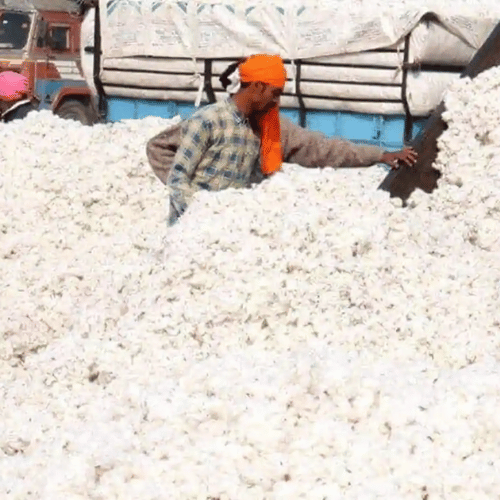Cotton is one of the oldest and most widely used fabrics in the world, but it also comes with a few cons. It’s important to know both sides of the story before making a decision about cotton.
The first thing to consider when discussing cotton is its versatility; it can be used for any type of clothing from t-shirts to dresses. Furthermore, it’s durable and can be used for years without losing its quality. Also, it has natural breathability that keeps you cool during hot weather.
On the other hand, some people are concerned about its environmental impact due to its use of pesticides and fertilizers. Additionally, it isn’t as soft or luxurious as other fabrics such as silk or cashmere. Finally, cotton requires more care than synthetic materials which can be difficult for some people.
In this article, we’ll explore the details on cotton and the benefits to see if you want to pick this material.
What Is Cotton?

Cotton is a soft, fluffy staple fiber that grows in a boll, or protective capsule, around the seeds of the cotton plants. It’s used to make clothes and other fabrics.
Its fibers are almost pure cellulose, making it the most important natural fiber in the world.
The main advantages of cotton are its breathability and softness. It’s also durable and hypoallergenic.
Moreover, it’s highly absorbent and resistant to shrinkage.
Cotton is also biodegradable and renewable, making it an eco-friendly choice for clothing. On the downside, it tends to wrinkle easily and can be expensive compared to synthetic fibers.
History Of Cotton Production

Cotton has been grown and processed for centuries. The first evidence of cotton cultivation dates back to 5000 BC in India, where primitive tools were used to spin and weave the fibers into cloth.
By 1000 AD, the technology had advanced enough that it was being exported to Europe. In the United States, cotton was a major industry by 1790.
It remained an important part of the American economy until the invention of synthetic fibers in the mid-20th century.
Today, cotton is still widely produced but with much more advanced machinery and technology than its predecessors.
Quality And Durability
When it comes to quality and durability, cotton is king. This natural fiber has been around since ancient times, and its longevity speaks to its superior qualities.
It’s known for its strength and durability, but it’s also highly breathable, making it a great choice for clothing.
And with advances in farming technology, today’s cotton is of an even higher quality than ever before.
Cotton fibers are resistant to stretching and tearing — so much so that they’re often used in items that need to be strong or last a long time, such as carpets, blankets, and upholstery.
In addition to being strong, cotton is also hypoallergenic and non-irritating on the skin. All these properties make it the perfect material for clothing — especially during warmer weather when you need something light and breathable.
Finally, because of its natural origin, cotton is biodegradable — meaning that once you’re done with your clothes or other items made from this fabric, you can simply throw them away without worrying about their impact on the environment.
Cotton may not be the most glamorous fabric out there (it’s not silk after all!), but when it comes to strength and durability there are few fabrics that can match it.
With proper care and attention, it will last for years — making it an excellent investment in the long run.
Comfort And Softness
Another one of cotton’s great qualities is its comfort. It’s light and breathable, meaning you won’t feel too hot or weighed down when wearing it.
Its softness also makes it a pleasure to wear — especially in direct contact with the skin — and it’s easily washable so you can keep your clothes looking clean and feeling fresh even after multiple wears.
Cotton also doesn’t tend to wrinkle as much as other fabrics, making it a great choice for those who don’t have time to iron their clothes every morning.
Cotton is not only comfortable to wear but also easy to work with too.
It’s a versatile material that can be used for many different types of garments, from plain t-shirts to elaborate dresses and everything in between.
And because it comes in various weights and textures, you can find the perfect fabric for any project you may have in mind.
All these qualities make cotton a great choice for clothing — whether you’re looking for something fashionable or just something comfortable to sleep in.
It’s a timeless fabric that will never go out of style, so you know your wardrobe will always look good no matter what season it is.
Plus, cotton is affordable compared to other fabrics like silk or cashmere, so you can stock up on pieces without breaking the bank.
Allergy Risk Factors
Despite its many advantages, cotton does come with some drawbacks. One of the most significant is that it can be a trigger for those who suffer from allergies.
The fibers in the fabric can cause irritation and itching, making it uncomfortable to wear. It’s also not hypoallergenic, so if you have sensitive skin, you may want to choose another type of material.
In addition, cotton isn’t as durable as some other fabrics.
Over time, it can become worn and faded with use and washing — something to keep in mind if you’re looking for something long-lasting.
And while some cottons are wrinkle-resistant, others will require ironing or steaming to look presentable after being stored away for a while.
On the whole though, cotton remains a popular choice for clothing due to its comfort and ease of care.
But before you invest in any items made from this fabric, it’s important to consider your personal needs and preferences — especially if you have any allergies or sensitivities.
With a bit of knowledge about the pros and cons of cotton, you’ll be better prepared to make an informed decision that works best for you.
Making this choice even more complex is the fact that cost considerations must also be taken into account when deciding which fabric is right for you.
Cost Considerations
Cost is a major factor when it comes to choosing cotton for clothing.
Generally, organic or Fair Trade certified cotton is more expensive than conventional cotton, but it’s worth the extra money for the environmental and social benefits.
Natural cottons like pima also tend to be pricier than other types. And if you’re looking for something that won’t break the bank, polycotton blends may be your best option.
It’s also important to remember that cost isn’t always an indication of quality.
Some fabrics may have a lower price tag but may not last as long or have the same level of comfort as others.
By understanding what makes each fabric unique, you’ll be better equipped to judge which one will give you the most value for your money.
No matter what type of cotton you choose, make sure it fits into your budget and meets your needs.
Taking into account all of these factors can help ensure that you’re getting a piece of clothing that will provide years of satisfaction.
Availability Of Different Types Of Cotton
With the rise of sustainable fashion, more people are looking to cotton as a preferred fabric choice. While it’s been available for centuries, there’s now an abundance of varieties that can be used to create clothing with different properties and looks.
From lightweight cottons like muslin and voile to heavier twills and canvas, manufacturers can choose the right type for their needs.
Additionally, fabrics like pima and organic cotton offer a softer feel while still providing durability.
It can sometimes be difficult to keep track of all the different types of cotton available on the market, so here is a quick rundown:
- Muslin: Lightweight and sheer, this fabric is perfect for blouses or summer dresses.
- Voile: A bit heavier than muslin but still light enough for spring and summer garments.
- Pima: Soft yet durable, this type of cotton is often used for luxury items such as bedding sets or formalwear.
- Organic Cotton: Grown without harmful chemicals or pesticides, organic cotton is both eco-friendly and comfortable to wear.
No matter what type of fabric you’re looking for, there’s sure to be a cotton option that will meet your needs — from affordability to sustainability. With this wide selection at hand, it’s easy to find something that fits your style as well as your budget.
Ethical Considerations
With so much variety of cotton fabrics now available, it’s important to consider the ethical implications of our purchases.
From the conditions of laborers’ working environments to the environmental impacts of production, there are several elements to take into account before making a purchase.
Here are five important things to consider when buying cotton products:
- Labor Conditions: Do the workers in factories producing cotton clothing have access to fair wages and safe working conditions?
- Responsible Sourcing: Is the cotton sourced from a responsible supplier that adheres to ethical standards?
- Sustainable Production: Is the production process sustainable and environmentally friendly?
- Animal Welfare: Are animals being treated humanely during any part of the production process?
- Traceability: Is there traceability for each step in the supply chain?
Taking these factors into consideration can help us make more conscious decisions when shopping for clothing made with cotton.
Knowing where our clothes come from and how they are made can give us peace of mind that we are supporting ethical brands and avoiding exploitation.
With this knowledge, we can be sure that our purchases not only look good but also do good.
Now that we understand some of the ethical considerations surrounding cotton products, let’s turn our attention towards proper care instructions for them.
Care Instructions For Cotton Products
It’s essential to know how to properly care for cotton products – from wash instructions to storage and more. With the right maintenance, cotton clothes can look great for years. Here are some tips to help you keep your cotton items in top shape.
First, it’s important to check the product label for specific washing instructions.
Most cotton garments should be washed with cold water on a gentle cycle and air-dried.
Avoid using fabric softeners or bleach as these products can damage the fabric over time. If necessary, tumble dry on a low setting or hang up to dry after washing.
When it comes to storage, make sure your cotton items are folded neatly and kept away from moisture and direct sunlight.
This will help preserve the color of your clothing and prevent fading or discoloration.
Additionally, avoid storing your clothes in plastic bags as this could cause mold or mildew growth due to trapped moisture.
It’s also important to inspect new garments before wearing them as they may have been treated with formaldehyde or other chemicals during production that could irritate sensitive skin.
Giving clothes an extra rinse before wearing is always a good idea!
Frequently Asked Questions
What Is The Best Way To Ensure That Cotton Products Are Ethically Sourced?
Ensuring cotton products are ethically sourced is of paramount importance. Through research and regulations, consumers can make sure their purchases are not contributing to the exploitation of workers or the environment.
There are a few steps that can be taken to ensure ethical sourcing:
a. Research: Consumers should familiarize themselves with the labeling and certifications associated with ethical sourcing and look for companies that have fair labor practices in place. Additionally, researching and understanding the environmental impacts of cotton production can help inform responsible buying decisions.
b. Regulations: The United Nations has put in place several regulations that promote ethical sourcing, such as the UN Guiding Principles on Business and Human Rights and the International Labor Organization’s Declaration on Fundamental Principles and Rights at Work. As these regulations become more widely accepted, they will help hold companies accountable for their sourcing practices.
These steps towards ethical sourcing must be taken seriously, as they will have an impact not only on people’s livelihoods but also on the environment.
By taking these precautions, consumers can make sure they are supporting businesses that prioritize sustainability in their practices.
What Is The Difference Between Organic And Conventional Cotton?
What kind of cotton should you use for your products? Organic or conventional? It’s an ironic question, because it implies that there is a choice, when in fact the answer could be much more complex.
Organic cotton has been grown without the use of synthetic fertilizers, pesticides, or herbicides.
It is thought to be better for the environment and may be a healthier option for those who wear the fabrics made from it.
On the other hand, conventional cotton is not as regulated as organic cotton. It can be grown with synthetic fertilizers, pesticides and herbicides but still maintain its quality.
The two types of cotton also differ in price.
Organic cotton costs more than conventional cotton, due to its stricter standards and regulations. This means that it’s harder to find organic cotton on the market and harder to produce large amounts of it.
Conventional cotton is less expensive and therefore more accessible to consumers looking for affordable fabrics.
When deciding whether to use organic or conventional cotton products, it’s important to consider both cost and sustainability factors.
Consider researching companies’ ethical sourcing practices before buying anything – this will help you make sure your purchase is supporting responsible producers and their workers around the globe.
Are Cotton Products More Expensive Than Other Fabrics?
Cotton products are a popular choice for apparel and bedding. But when it comes to cost, how do they measure up to other fabrics? To answer this question, we need to consider the production costs, quality, and availability of cotton.
Organic cotton is more expensive than conventional cotton because of increased production costs.
For example, organic farmers must use natural fertilizers and pest control instead of synthetic ones. This requires extra labor and expense that affects the final price of the product.
Additionally, organic cotton fibers tend to be shorter than conventional ones, resulting in lower yields per acre of land.
In terms of quality, many people believe that organic cotton is superior because it is grown without chemical pesticides or fertilizers.
It’s softer and more durable than conventional cotton, making it ideal for those who have sensitive skin or are looking for clothing items that last longer.
However, the price tag may be higher due to its rarity and higher production costs.
When it comes to availability, both organic and conventional cotton products are widely available in stores and online.
Organic products may be harder to find since they usually come from smaller farms with limited supplies. That said, if you’re willing to shop around you can usually find a good deal on either type of product.
Ultimately it’s up to you whether the extra cost associated with organic cotton is worth the benefit in terms of quality or environmental consciousness.



